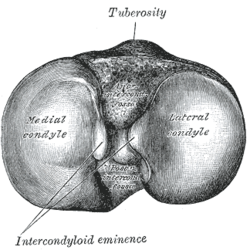| Condyle | |
|---|---|
 Upper surface of right tibia. Upper surface of right tibia. | |
| Details | |
| Identifiers | |
| Latin | condylus |
| TA98 | A02.0.00.029 |
| FMA | 75434 |
| Anatomical terms of bone[edit on Wikidata] | |
A condyle (/ˈkɒndɪl, -daɪl/; Latin: condylus, from Greek: kondylos; κόνδυλος knuckle) is the round prominence at the end of a bone, most often part of a joint – an articulation with another bone. It is one of the markings or features of bones, and can refer to:
- On the femur, in the knee joint:
- On the tibia, in the knee joint:
- On the humerus, in the elbow joint:
- Condyle of humerus (Condylus humeri)
- On the mandible, in the temporomandibular joint:
- On the occipital bone, in the atlanto-occipital joint:
Although not generally termed condyles, the trochlea and capitulum of the humerus act as condyles in the elbow, and the femur head acts as a condyle in the hip joint.
Condyle may also be used to describe an intrusion of the endocarp into the seed cavity of flowering plants like Abuta.
References
 The dictionary definition of condyle at Wiktionary
The dictionary definition of condyle at Wiktionary
- OED 2nd edition, 1989.
- Entry "condyle" in Merriam-Webster Online Dictionary.
| Bone and cartilage | |||||||||||||||
|---|---|---|---|---|---|---|---|---|---|---|---|---|---|---|---|
| Cartilage | |||||||||||||||
| Bone |
| ||||||||||||||
This human musculoskeletal system article is a stub. You can help Misplaced Pages by expanding it. |